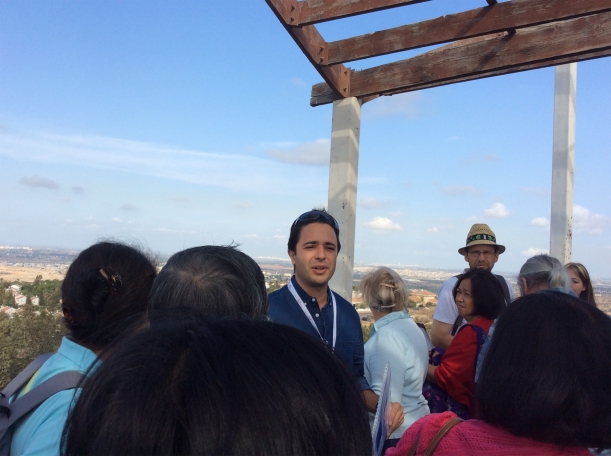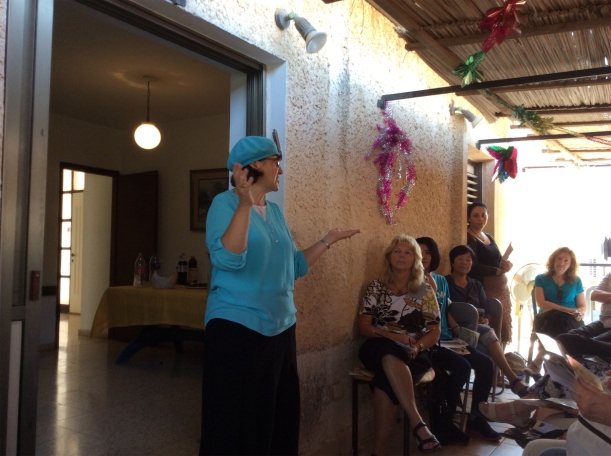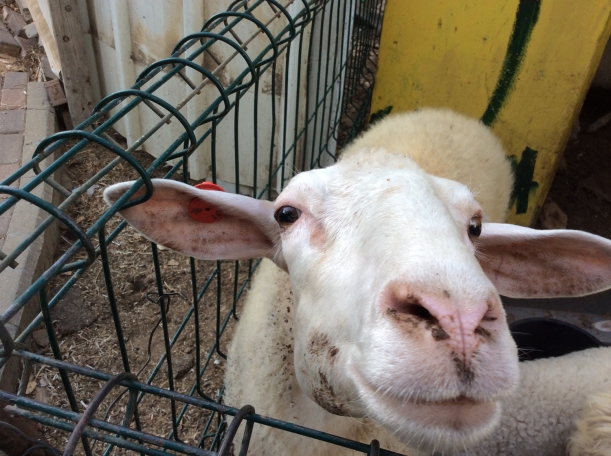I was watching a movie at Old Shilo with a group of Christians. The actor leaned into his wife and said, “Hannah, why are you weeping? Why don’t you eat? Why are you downhearted? Don’t I mean more to you than ten sons?” I Samuel 1:8
The women erupted in laughter and for the first time on my tour of Samaria, I felt that the group wasn’t split into 50 Christians and two Jews, but a split between men—with big egos—and women with a sense of humor about these men with big egos.
The words were spoken by Elkanah, the husband of Hannah in a movie recreating events from Ancient Shilo. For 369 years Shilo was the spiritual and governing capitol of the Jews. This is where the High Priest Eli dwelled, where Joshua ruled and where the Tabernacle rested. Ancient Shilo is in Samara, known to most of the world as the West Bank.
This is where Hannah prayed for a child and her lips mouthed fervent prayers but her words were not audible. The High Priest, thinking she was drunk, asked what she was doing. She answered that she was praying for a child. He told her that her wish would be granted and, indeed, she gave birth to Samuel, the last of the Judges. Hannah’s manner of praying became the template for Orthodox women’s prayers.
But let’s backtrack to find out why my husband and I were the only Jews and only Israelis on this bus of Christian tourists. It was simply a mistake. When the mistake was pointed out to us two weeks before the tour, by the leader, we decided to stick to our original plan. We wanted to see more of Samaria and we especially wanted to see Ancient Shilo. I was curious about the group CFOIS because the leader is the daughter of a friend’s friend in Chicago. But now that I was reminded that it was a Christian group I was also curious to find out who are these people who want to support Israeli settlements. By the way, CFOIS stands for Christian Friends of Israeli Settlements.
So, when the chag of Sukhot was fast approaching and we were still planless I immediately ran this offer by my husband and he seconded the emotion, “Let’s go!”
The night before we contemplated who would be on the tour with us. We expected to be surrounded by American tourists. Not so. There were a few Americans, but the other tourists were mostly from Singapore, Australia, England, Germany, Holland, South Africa and the Philippines.
Our tour guide, Moshe Gabay, was born in Switzerland and immigrated to Israel when he was 19. His personable presentation, his great knowledge of the area, and his concern as a host made everyone feel welcome. What really surprised me, though, was the enthusiasm these Christians vociferously demonstrated with their shouts of Hallelujah and amen when Moshe spoke about why Judea and Samaria belong to the Jews biblically and why great parts of it need to be incorporated into Israel so that Israel is not defenseless against its hostile neighbors. Our first stop at Alfei Menashe demonstrated this more powerfully even than his words.
On the way, Moshe entertained us with stories. He told us all about a new textbook in Holland that states that Israel refused to come to the negotiating table with Jordan after the 1967 war. In fact, it was Jordan that refused to come to the table. When this error was brought to the attention of the publishers of the textbook by Moshe’s brother-in-law, a teacher in Holland, they agreed he was correct. They also made it clear that they had no intention of changing this incorrect statement. This small reminder of the bias of the entire world against Israel and Jews is screamed at us from headlines of most newspapers, especially “The New York Times” and shouted at us by CNN and BBC on a daily basis. This made those “Hallelujahs” and “amens” so poignant, that I had to fight back tears.
At Alfei Menashe, from our high location, we were able to see Tel Aviv and Haifa without the aid of binoculars. Alfei Menashe is geographically 1.2 miles beyond the Green Line at the point where Israel is the narrowest: 15 km (9.3 mi). This scenic peaceful view blew up any fantasy one might have that Israel could just hand over this territory and survive.
Moshe Gabay explains the danger of protecting Israel against our enemies where the country is less than ten miles wide.
The lookout has a stone memorial plaque, one of the hundreds all over Israel honoring those that sacrificed their lives for their country.
Next stop: the home of Sonda Oster Baras, an attorney in the US who came to Israel years ago and practiced law here before her passion of presenting Israeli’s case to Christians became her full time vocation. . Her living room tables were set up with snacks and drinks and Sondra welcomed all to take our goodies into her sukhah where she spoke about CFOIS and their support of the settlements in Judea and Samaria. Afterwards someone in the organization made a pitch for donations. I was suddenly beamed back to one of my first visits to Israel as an American on a Jewish National Fund tour. That tour’s destinations were mostly JNF projects and they cheerfully solicited donations to enable them to build more projects just as CFOIS was now doing.
Sonda Oster Baras hosts the tourists in her sukhah in Karnei Shomron
We visited several settlements high in the mountains. From the lookouts Moshe pointed out the hostile Arab villages around us including Jenin. Jenin is the home of the Hamas murderers of Eitam and Naama Henkin; murderers that gunned down this loving couple in front of their four young children in Samaria the day after our tour. The children were spared only because one of the terrorists so intent on killing, shot the hand of one of his fellow terrorists by mistake. The five terrorists then aborted the attack to take him to the hospital, where he was later arrested.
We visited several yashuvs (settlements) including Rechalim for a wine tasting which also included imbibing two ounces of pure olive oil. Our hostess explained that olive oil is a great health tonic and especially good for hair growth. While I love olive oil on salads and fish, I drank this only because I was worried that if I didn’t drink the olive oil they wouldn’t give me the wine, much like my parenting: you don’t eat the main dish you don’t get dessert.
At the end of the tasting, I was faced with a personal financial predicament. Being on a budget, I usually spend between 30 and 40 NIS ($7.50 to $10) for a bottle of superior wine for Shabbat (yes, wine is very inexpensive in Israel) and about 25 NIS ($6.50) for wine to drink during the week. Here their wines were 135 NIS ($34). My passion to support those businesses in the Shomron (Judea and Samaria) won out and I purchased a bottle of Merlot and a bottle of Shiraz plus a nifty bottle stopper for the bargain price of 15 NIS. We wandered around the yashuv which was the poorest one I that we saw that day. In Israel there are playgrounds for children everywhere. Here too, but they were shoddy. Most of the housing looked extremely uncomfortable. There are only about 40 families living there. At grape picking time the yashuv is short on labor. Moshe Gabay brings in Christian volunteers from Europe to help harvest the grapes.
As we started to re-board the bus, several of the Filipino women asked me to pose for photos with them. I felt like a local dignitary.
Our next stop, and the one we were most excited about, was Ancient Shilo. Ancient Shilo was dressed in circus finery celebrating the Feast of Tabernacles (Sukoht). There were at least 30 booths hosted by craftsman for tourists, mostly for children to make replicas of the pottery and jewelry found there. Other booths featured entertainers wearing the garb of that time. We saw dozens of children sporting colorful tunics that they made in one of the booths. After spending a little time in their tourist shop, my husband purchased a beautiful handmade replica of the breast plate worn by the Cohan Gadol (the High Priest at Ancient Shilo and the First Temple) for my upcoming birthday. Their plate had 12 jewels and the jewels would light up in a pattern for the High Priest to decipher the answer to the question they presented to G-d.
Our last stop was Maale Levona where they have about 120 families and a petting zoo. This yashuv is also in a strategical place in the Shomron needed for the protection of Israel. The zoo has a double purpose. It is not just for the children that live there but special needs children come to this zoo as petting animals is very therapeutic. CFOIS is helping to fund this petting zoo, and more importantly, is now collecting monies for security cameras and other equipment that will help the residents protect themselves against attacks by Arabs.
Waiting to be petted
On our way back we were forced to take a detour. Our guide suggested that this would bring us back to our starting point faster. There had been more traffic than anticipated and we were running behind schedule. The next day we discovered that the detour was probably imposed on us by the police because of rock throwers.
On the festival of Shemini Atzaret, the festival at the close of Sukhot, we begin to pray for rain. So on our way back when we were pelted with rain that started even before we began to pray for rain, we took it as a good sign. As for me, I took great heart in knowing that amongst all the BDS supporters, rabid reporters of twisted news always in favor of the Palestinians such as BBC and CNN, that there are good people who understand what Israel is going through and support Israel with their hearts and their pockets.



